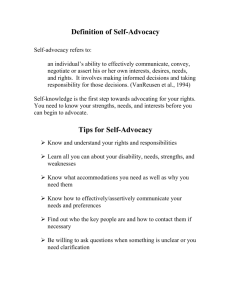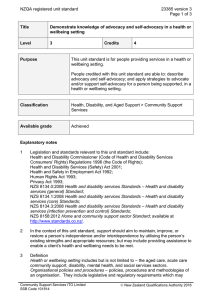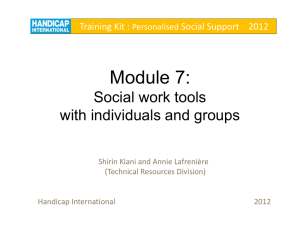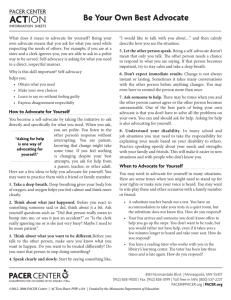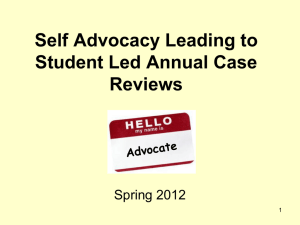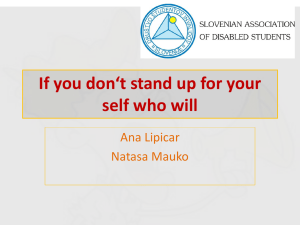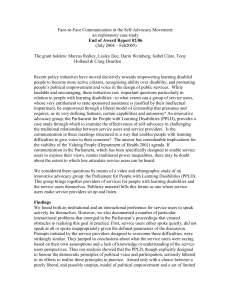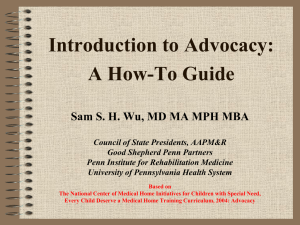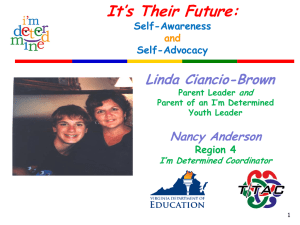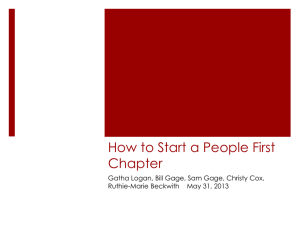Self Advocacy - Intermediate District 287
advertisement
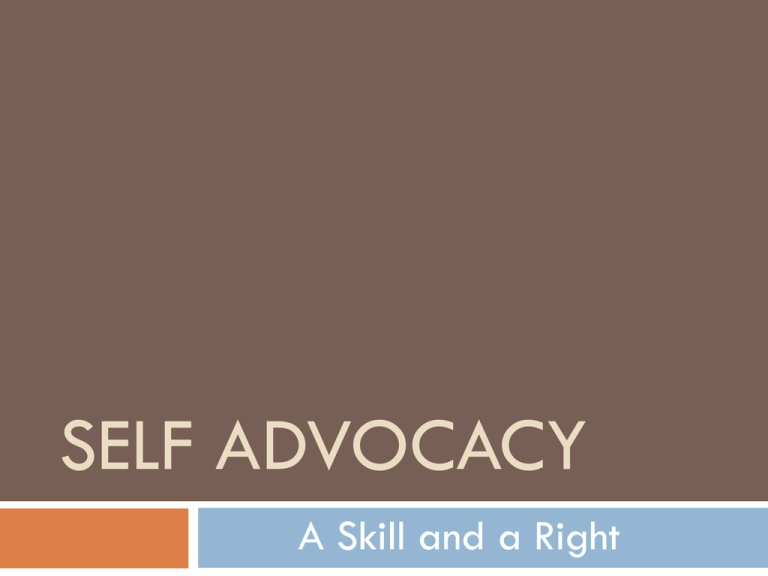
SELF ADVOCACY A Skill and a Right Definition of Self-Advocacy Self-advocacy refers to: an individual’s ability to effectively communicate, convey, negotiate or assert his or her own interests, desires, needs, feelings and rights. It involves making informed decisions and taking responsibility for those decisions. (VanReusen et al., 1994) Self-knowledge is the first step towards advocating for your rights. You need to know who you are - your strengths, areas of challenge, values, and interests before you can truly be a self advocate. To be a self advocate one needs to know self know what they need and want know how to get what they need & want communicate in a timely and effective way – being assertive versus aggressive Six success attributes that highly correlate with self advocacy Self awareness Being proactive Perseverance Goal setting The presence and use of support systems Emotional coping strategies Raskind and Goldberg (2005) 1. 2. 3. Why is it important to include selfadvocacy skills into my curriculum / our program? How are we going to find time to do that? What would we do? Why? Students need to learn how to advocate for themselves at their job in the community during their school day in daily living situations with their friends and family We need to support and encourage them as they learn this critical life skill Can your students ask their boss to explain a new task AND show them how to do it before they walk away? promote their idea among a lot of ideas for a Saturday night gathering with friends? know when and how to share what they were thinking and feeling when there was a huge misunderstanding with their group of friends and no one is talking? problem solve how to get a ride somewhere when everyone seems to have other commitments? Barriers to Assertiveness/Self-Advocacy Feeling quiet and too shy to speak Feeling frustrated and ready to explode Feeling like I don’t know what to do Feeling afraid of saying the wrong thing Not knowing how someone else will react Wanting to be nice to everybody Not wanting to cause a problem Not wanting to draw attention to myself Thinking that no one will understand me Not liking the other person / situation enough to try Other barriers that you have witnessed? What stops students from being their own advocate? Figure out what the barriers are Come up with a plan to work through the challenges, build their skills, provide opportunities for supported practice and help them overcome their resistance/fear. “Growing” Self-Advocacy Do your students . . . . Know and understand their rights and responsibilities Know their abilities, needs, gifts, strengths, and challenges Know what accommodations they need as well as why they are needed Know how to effectively communicate their needs, ideas, feelings and preferences Know who their key people are and how to contact them if necessary Know how to ask questions when something is unclear or confusing. Opportunities for Growth How mindful are we, as facilitators of students’ learning and communication skills, in providing opportunities for growing their self advocacy? Take a minute to share 3 ways you promote self advocacy skill development in the natural contexts and daily schedules of your students. Supporting students to become self-advocates… Teach youth about their disability and assist them to recognizing their strengths, talents, skills and support needs. Teach skills such as: requesting assistance, making choices, expressing an opinion, and sharing information. Encourage youth to “speak up” for themselves rather than relying on an adult to it (we support but not do it for them) Step by step, we encourage them to . . . Learn how to make informed choices for self Identify their needs and wants Share information with someone they trust Practice what they want to communicate Speak for self; find their voice first in easy situations then in harder ones. Not give up if people don’t listen the first time Celebrate each effort and accomplishment Students should know and be comfortable with: Discussing his / her disability What accommodations are helpful, those that are not, and why Understanding their rights and responsibilities Articulating their strengths and challenges Discussing what works and doesn’t work for them in the various environments they may encounter Knowing and discussing overall learning style How does staff support students to be self advocates? Provide opportunities for students to make choices Encourage assertiveness Partner with students to set their own goals Allow youth to take risks and make mistakes but also facilitate the processing and learning from those mistakes It is helpful for students to create a Personal File of pertinent information that can aid them in self-advocacy Some ideas for things to include Medications, Pertinent Medical People IEP / Transcripts Photos of projects, activities, volunteer experiences Copies of financial aid forms Medical (and vehicle) insurance information Important addresses & phone numbers Copy of birth certificate, drivers license Social Security card Everyone has the right . . . Every student, regardless of their disability and abilities has the right to communicate what works and doesn’t work for them, what brings them joy, the interests they would like to pursue/continue to pursue, what makes them fearful or angry, the situations where they like to have a choice or some degree of control. Our work is to help them strengthen and use their communication skills to grow their self advocacy muscles so their are better prepared to navigate the variety of situations their adult life will surely bring. Courage doesn't always roar. Sometimes courage is the quiet voice at the end of the day saying, "I will try again tomorrow.” Mary Anne Radmacher Questions? Ideas? Ah-ha’s?
